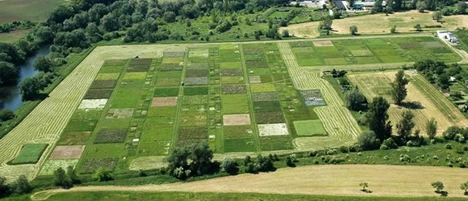Biodiversity and ecosystem functioning

Over the past decades, an increasing number of studies has analyzed the relationship between biodiversity and ecosystem functioning triggered the documentation of a global and ongoing loss of biodiversity. We research the ecosystem consequences of biodiversity loss in various projects. The longest-running and still ongoing project is the DFG-funded Jena Experiment, a grassland biodiversity experiment (coordinated by our research group from 2002-2017) with large plots and up to 60 plant species. In 2020 we have established another biodiversity field experiment as part of a global network of experimental sites (LegacyNet) to study the functional effects of diverse grassland leys both during the grassland phase and during the following crop (legacy effects). In the BMBF-funded BIOLOG DIVA-Jena project (completed at the end of 2010), we studied semi-natural grasslands spanning a plant species richness gradient. A major conclusion that can be drawn from this research is that low diversity in an assemblage is often associated with a lowered mean (and an increase in the variance) in many of the ecosystem variables investigated. In the Jena Experiment, for example, about 40% of ecosystem variables are affected by plant species richness. One major shortcoming of the current state of knowledge is, however, that for many of the observed biodiversity effects we do not know the underlying mechanism. We are interested in how species interactions change with increasing plant species richness and how these changes underlie the observed biodiversity effects on ecosystem variables.
Jena experiment
The Jena Experiment is one of the largest and longest-running biodiversity experiments worldwide. Grasslands of controlled plant species richness that form a diversity gradient from monocultures over combinations of 2, 4, 8, and 16 species up to communities with 60 different plant species are investigated since the year 2002. We analyse how plant diversity changes functions and properties ranging from abiotic conditions to species interactions, from above- to belowground, and from plants to top predators. These analyses are based on a large pool of data collected during the last 18 years by members of the research unit and are currently continued within the doctoral thesis of Laura Argens. We measure rates of herbivory and predation investigating their relationship to plant diversity, plant traits, and changes in the community of aboveground consumers in the doctoral thesis of Maximilian Bröcher together with Anne Ebeling (FSU Jena) in Subproject 5: Plant-consumer interactions as cause and consequence of long-term BEF relationships.
LegacyNet
The benefits of multi-species mixtures for many ecosystem processes are well known from ecological research in grassland biodiversity experiments. Now, we wish to apply these findings to benefit agricultural practices. Therefore, LegacyNet (https://legacynet.scss.tcd.ie/) investigates how to best design grassland leys within crop rotations to maximize the function of the ley as a grassland, and to maximize the carry-over effect of the grassland (supply of symbiotically fixed nitrogen, soil health and fertility).
In 2020, we have established a field site with 60 plots of 3x7m in Freising as part of a network of experimental sites following a common experimental design. The main treatments are grassland mixtures consisting of grasses, legumes and herbs (from monoculture up to six species and 10 species high-diversity controls), and a follow-on cereal crop to quantify the legacy effect of the grassland composition. In addition to quantifying the grassland yield, we monitor the activity of insects and small mammals in the plots as well as quantifying proxies for ecosystem processes (pollination, predation, seed dispersal using REFA methods).